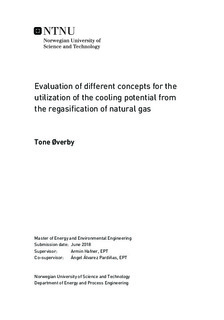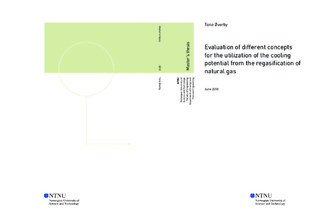| dc.description.abstract | The increasing interest in energy efficient solutions, and working towards a more sustainable future, give rise to the importance of utilization and thus reduction of the current wastage of excess energy today. As the total energy demand in the world increases, both renewable energy and the use of more environmentally friendly fuels compared to coal and oil, have become significant. Natural gas can be considered as both purer and more environmental friendly and serves as an important energy carrier for the future. However, the intensive energy use during its production and distribution can be made more efficient. As 50% of the natural gas today is provided by liquefied natural gas at about -162 °C, a large cold energy potential is introduced. Nonetheless, it is poorly recovered at the regasification terminals, mainly wasted to the sea. The aim of this Master Thesis is thus to reveal and evaluate different concepts for utilizing this potential.
Japan is proven to be at the forefront of exploiting the mentioned excess cold energy. At the Senboku terminal, an installation of multiple cold recovery systems recovers 100% of the available cooling potential. However, at the 37 LNG terminals in Europe, the utilization level is rather low. Only a few installations exist, including a 4.5 MW Rankine cycle at the Huelva plant and 5.5 MW turboexpanders at the Barcelona terminal in Spain. For that reason, system configurations for cold energy recovery into refrigeration applications, with CO2 as working fluid, as well as auxiliary power generation were designed in this study. In addition, a calculation tool with the dynamic simulation software Dymola was developed, serving the purpose of analyzing the potential energy savings related to the system designs.
Moreover, a scenario analysis was performed, looking into variable regasification demand at the two configured cold recovery systems: a supermarket refrigeration system and an Organic Rankine Cycle. The conducted simulations confirmed the huge available cooling potential for further usage. A number of 435 supermarkets, with the designed refrigeration system, were found necessary to cover a regasification demand of 10 kg/s, indicating that multiple cold recovery systems are substantial for an efficient utilization of the LNG cold. A closer temperature fit between the heating of LNG and the cold recovery systems for the inclusion of an auxiliary power generation, confirmed the observation.
Additionally, a cost estimate and emission analysis were carried out based on the simulated scenarios. A large reduction in operational costs could be observed for both the refrigeration system and the included auxiliary power generation, even an estimated annual income of about 664,561 NOK for the latter case. Regarding the emission analysis, an assumption of no cold recovery at all for an annual global natural gas trade of 346.6 billion m3 in 2016, resulted in a total potential reduction of about 213,759 ton CO2. | |

